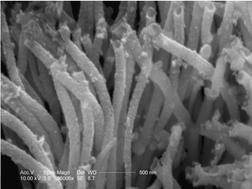Plasma-aided template synthesis of inorganic nanotubes and nanorods
Abstract
This work presents a new sol–gel deposition method to synthesize high purity SiO2 and ZrO2 nanotubes and nanorods using track-etched membrane templates. Oxygen plasma pretreatment ensures pore-filling of the precursor solution and covalent bonding between template and precursor, while pyrolysis of the template–nanostructure composite completely removes organics and produces inorganic nanostructures. The nanotube/nanorod aspect ratio was tunable by the pore size and thickness of the template, while the wall thickness (from tube to rod) was controlled by the precursor concentration. The solvent-free plasma treatment and pyrolysis provide an efficient synthetic route to produce high purity inorganic nanostructures.


 Please wait while we load your content...
Please wait while we load your content...